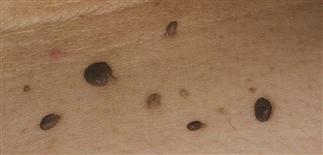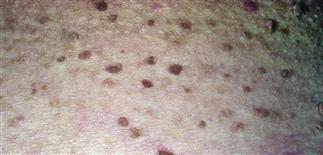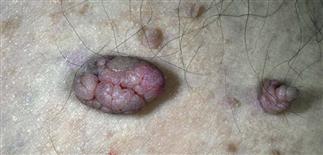116
Skin tags

Skin tags (acrochordons) are fleshy pedunculated papules found in the intertriginous area. They are usually soft and non-tender, but may become inflamed and irritated with friction.

Skin tags are tiny, brown or skin-colored, oval papules attached by a short, broad to narrow stalk that become elevated with time, and eventually come to protrude from a narrow base.

In the axillae, skin tags will be grouped together in various sized from 1 to 3 mm, and various degrees of pigmentation.

As a result of their location, skin tags may become irritated by friction, jewelry, or clothing.
DESCRIPTION
Skin tags, or acrochordons, are common, benign, small, fleshy papules occurring in the skin folds.
HISTORY
• Roughly 25% of adults have at least one skin tag. The majority of patients with skin tags have only a few such lesions. Uncommon before the age of 30, common thereafter. More common in overweight persons. • There may be a familial tendency toward multiple skin tags. • Undisturbed lesions are usually asymptomatic. • Skin tags may become irritated by friction, jewelry, or clothing. They may become tender and may bleed when traumatized, twisted, torn, or thrombosed.
PHYSICAL FINDINGS
• Skin-colored or slightly pigmented, 1- to 5-mm fleshy, pedunculated papules. May be flat or filiform, although most are soft, fleshy, and pedunculated on a thin stalk. • Typically not difficult to diagnose. • The axillae are the most common location. Also, the neck, eyelids, and intertriginous areas such as the inframammary and inguinal creases. • The overwhelming majority of skin tags are benign and have no internal disease association. However, skin tags are part of the Birt–Hogg–Dubé syndrome, a rare condition that includes trichodiscomas and fibrofolliculomas of the face, neck, and chest. Patients with this syndrome may have associated renal cell carcinoma, colonic adenomas, pulmonary cysts, and medullary carcinoma of the thyroid gland.
TREATMENT
• Asymptomatic skin tags do not require treatment. Patients often request removal for bleeding, tenderness, or cosmetic reasons. • Skin tags are best treated by scissors excision with or without local anesthesia. Electrocautery and cryosurgery can also be used. • Many dermatologists feel that histologic confirmation is usually not necessary, but submission of all skin tags for histologic review is a topic of debate.







